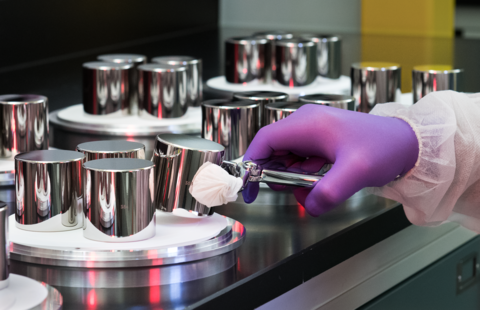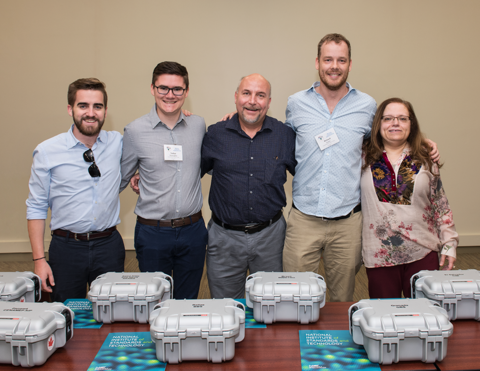White Cat Hair on Black Pants: International Study Measures Stability of Precision Masses to Benefit Trade

When are two nominally identical kilogram masses no longer identical? When each goes to a different place and adsorbs varying amounts of moisture and contaminants.
Exploring this issue, the U.S. National Institute of Standards and Technology (NIST) and the National Research Council (Canada) are collaborating with measurement laboratories in North, Central and South America to better understand how the masses of precision weights rise and fall over time.
They hope the results will benefit international trade, in which even small measurement inaccuracies can have significant impacts.
To ensure that a pound of potatoes at the grocery store really weighs a pound, a store’s balance must be calibrated regularly. For this kind of calibration, consumers ultimately rely on mass artifacts, pieces of metal whose mass has been precisely measured. Scientists know the mass because each artifact has in turn been compared to other artifacts in an unbroken chain of comparisons that stretches back to the fundamental definition of mass itself.
Standards laboratories maintain a bevy of mass artifacts for comparisons such as these, which are ultimately used to calibrate everything from grocery balances to bathroom scales. From time to time, these labs require an additional or replacement mass artifact for their collection.
In the first few months of its life, however, the mass of a new artifact can change significantly as the freshly cut metal adsorbs molecules from its environment.
There is some disagreement about how long scientists must wait before they can be certain a new artifact’s mass is stable. So, NIST and NRC Canada designed the massive new experiment to help resolve this issue.
The experiment involves 60 nominally identical one-kilogram weights, ordered to be made from a single rod of high-quality stainless steel. About half of these 60 units have been distributed to 29 countries within the Inter-American Metrology System (SIM), a network of national metrology institutes (NMIs) located in North, South and Central America, as well as island nations.
For a year or more, the SIM representatives for each country will measure the mass of their artifact every few months and send NIST and NRC Canada the data. They will also monitor each mass’ environment, including the lab’s temperature, barometric pressure, humidity and volatile organic compounds (VOCs), a measure of air quality.
“The whole thing is going to be a massive stability study on a scale that no one’s ever done before,” said NIST physicist Patrick Abbott. “Because the masses are taken from the same rod of steel, you would expect that they might have the same long-term response.” However, the conditions in the different SIM laboratories are expected to affect the rate at which the masses change, depending on qualities such as altitude and the amount of salt in the air. For the first several months of their lives, the masses were kept in the U.S. and Canada. Now, half of them will be stored in laboratories near the equator and well into the southern hemisphere.
“So how are the masses going to change?” Abbott said. “Once they get down there, they’re not necessarily going to follow the same pattern as they do in North America.”
Cat Hair on Black Pants
A new artifact, freshly cut, is like a sponge: It collects molecules from the air, and this increases its mass slightly over time. The new artifacts used in this experiment are less than a year old and, therefore, in a stage of relatively rapid weight gain on the order of 7 micrograms (millionths of a gram) over six months. This might sound too tiny to matter, but even small changes—especially if they are unpredictable—can raise uncertainties in laboratory measurements.
“These weights are changing,” Abbott said. “They’re picking stuff up from the air—sort of like the black pair of pants in a house with a white cat.”
At some point, that process usually stops or slows down significantly. The question is, how long does a laboratory have to wait before it can be sure its mass has reached a stable phase? And how does that period change depending on the lab’s location and average environmental conditions?
Previous studies have tended to be small-scale, conducted in a single laboratory. Abbott and his NIST and NRC Canada colleagues wondered whether a larger-scale effort would help resolve discrepancies in earlier results.
“Right now, a lot of the studies that have been done have been very localized: one lab, one person, under one set of conditions,” Abbott said. “But another person in another lab might do the same study and say, ‘under these conditions, we got something completely different,’” he continued. So, who is right?
“Hopefully this study will be able to answer the question: If you buy a mass for your lab, what is a reasonable expectation of when you would actually be able to put it into service, and have confidence in it?” Abbott said.
More Than Mass Alone

Before distributing the artifacts, NIST and NRC Canada fully characterized them by measuring their density as well as their magnetic susceptibility, a quality of how the material behaves when it is exposed to a magnetic field. Each institute took half of the masses: NRC Canada took the even-numbered ones, and NIST took the odd-numbered ones.
To measure the densities of their half of the weights, the Canadian scientists used a hydrostatic technique that involved weighing each artifact successively in fluids of different known densities. Meanwhile, NIST conducted their tests aerostatically, using a pressure chamber that could weigh the artifacts in different air densities.
Though all the masses were supposed to be nominally identical, Abbott was surprised to find that the first 15 weights he measured had a distinctly different density from the second 15. He worried he had made a mistake—until he found out that his Canadian counterpart had measured the same discrepancy in their weights.
“It turned out the manufacturer used two different bars of steel that had slightly different densities,” Abbott said, “and we saw it in our measurements.”
When they exchanged data to see how closely the numbers aligned, Abbott said, “it was beautiful, just beautiful. We used two very different techniques, and there was excellent agreement for this study.”
Earlier this month, NIST and NRC Canada distributed 29 of the 60 masses, one to each of the participating South and Central American countries. The remaining artifacts will be kept and monitored by NIST and NRC Canada until the study is complete.
Until May 19, 2019, the world’s definition of mass will continue to be based on the International Prototype Kilogram (IPK), a cylinder of metal forged in the late 19th century and kept at a laboratory outside of Paris, France. After this date, the formal definition of a kilogram will be redefined to rely on a fundamental constant of nature. However, kilogram artifacts are still expected to be used in many applications, including disseminating the new mass standard. For more information, see Redefining the World’s Measurement System: The Kilogram.
– Reported and written by Jennifer Lauren Lee

